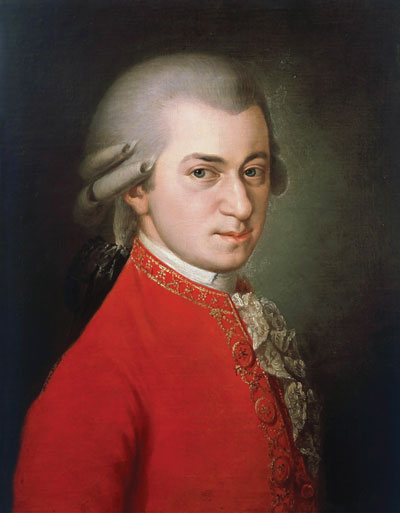Wolfgang Amadeus Mozart

Born: January 27, 1756, in Salzburg, Austria
Died: December 5, 1791, in Vienna, Austria
Overture to Die Zauberflöte ("The Magic Flute"), K. 620
- Composed: 1791
- Premiere: September 30, 1791, Theater auf der Wieden, Vienna, Mozart conducting
- CSO Notable Performances:
- First: February 1906, Frank Van der Stucken conducting
- Most Recent CSO Subscription: April 2021, Louis Langrée conducting
- Most Recent: March 2023 at a Young People’s Concert, Samuel Lee conducting
- Instrumentation: 2 flutes, 2 oboes, 2 clarinets, 2 bassoons, 2 horns, 2 trumpets, 3 trombones, timpani, strings
- Duration: approx. 6 minutes
Wolfgang Amadeus Mozart finished his last opera, The Magic Flute, during the summer of 1791 and conducted the premiere in September of that year at the Theater auf der Wieden in Vienna. Just three months later, gravely ill and bedridden, Mozart died at the age of 35. His health had been deteriorating for some time, as had his financial standing. The years leading up to his death had been challenging—his popularity as a performer was waning and Vienna’s economy was struck with the repercussions of the Austro-Turkish War, leaving previous benefactors unable to support the arts. But 1791 began more promisingly and Mozart was incredibly productive before his illness took hold, composing a final piano concerto, his beautiful Clarinet Concerto and the unfinished Requiem, in addition to The Magic Flute.
During his short lifetime, Mozart revolutionized the world of opera by deepening the connection between music and drama and exploring the emotions behind characters with the use of rich orchestral writing. When he first began composing operas, the genre was dominated by Italian composers, who developed a style that was all the rage across Europe. Mozart’s early operas were all sung in Italian and his collaboration with the librettist Lorenzo Da Ponte cemented his status as a master of the form. Their work together brought about Mozart’s most famous operas, The Marriage of Figaro, Don Giovanni and Così fan tutte.
The Magic Flute, in contrast, is written in the German Singspiel tradition, in which set musical numbers are interspersed with spoken dialog—a genre now seen as an early precursor to the American musicals of Broadway. For this libretto, Mozart worked with his friend and fellow Freemason Emanuel Schikaneder. Schikaneder was a jack-of-all-trades in the Vienna theater scene and the pair used his theater to produce their opera. The plot draws inspiration from Enlightenment philosophy with an overall message of love and goodness triumphing over darkness and fear. Underlying the multiple plotlines of the opera are references to the Masonic beliefs and rituals that Mozart and his librettist held so dear, including themes of brotherhood and moral discipline.
The plot takes place in a mythical land and revolves around the heroic Prince Tamino and his companion Papageno, a creature who is half-man and half-bird. They are sent on a quest to rescue the Queen of the Night’s daughter, Pamina, who has been captured by the evil Sarastro. Tamino, who falls instantly in love with a picture of Pamina, is given a magic flute that will keep them safe on their journey. Papageno receives bells, also infused with enchanting properties. The instruments, along with three spirits who help offer guidance, are used to charm wild animals and enemies on their way. Upon arriving at Sarastro’s temple, the duo must undergo a series of trials to prove their worth. Similarly, Tamino and Pamina must face the ordeals of passing through fire and water before they can be united. Finally, Sarastro blesses the young couple and hails their courage and wisdom. Papageno finds a wife in the mystical Papagena, and the Queen, who has turned out to be the evil one, is banished by the light of the dawning sun.
The opera’s overture opens with three declamatory chords and a slow, somber introduction. These chords are taken from Act I of the opera, when the travelers have reached the daunting entrance to the temple. Following the chords, the music drifts into a minor harmony and seems to hover with hesitation. Then, seamlessly, Mozart delves into the fast Allegro section and a joyful fugal passage full of offbeat accents and dynamic contrasts. The fugue is not taken directly from the opera but the infectious spirit in the music reflects the exuberance and humor of the opera’s hero and sidekick. The opening three chords return to interrupt the activity in a moment of reflection before the music rushes off again in a brilliant display of counterpoint and melodic development.
The number three is highly significant in Freemasonry and pervades the entire score of The Magic Flute, imbuing the opera with symbolism. It is written in the key of E-flat, a key signature made up of three flats; the plot revolves around the three couples of Tamino and Pamina, Papageno and Papagena and the Queen of the Night and Sarastro, and three spirits help the hero and his heroine through three ordeals before they can be united. Mozart finished this overture just days before the opera’s first performance. Before succumbing to his fatal illness, he was able to witness and revel in the immense success of this original and brilliant opera.
— Catherine Case